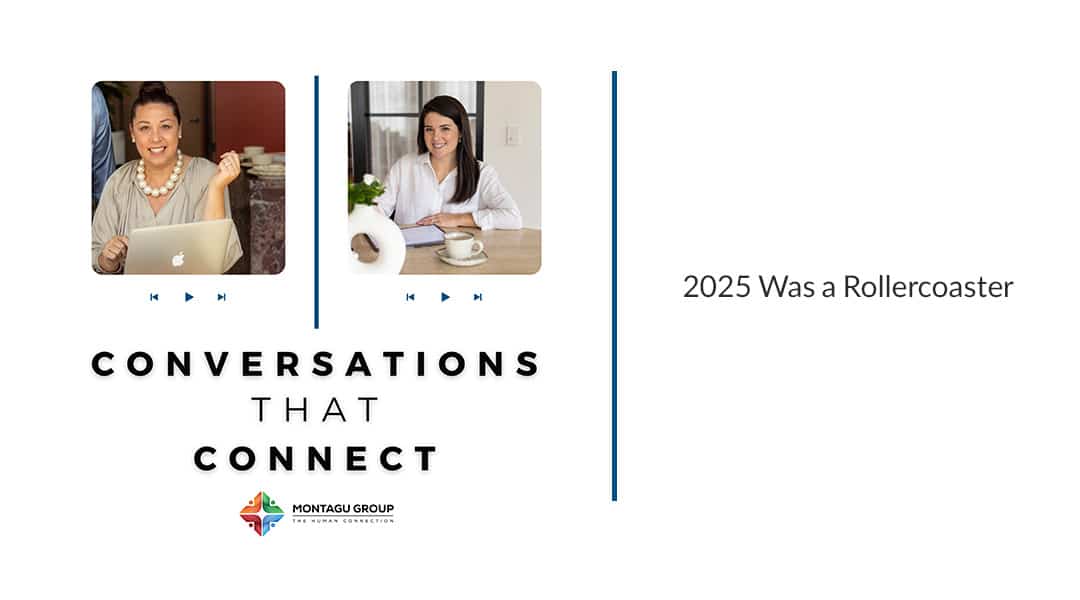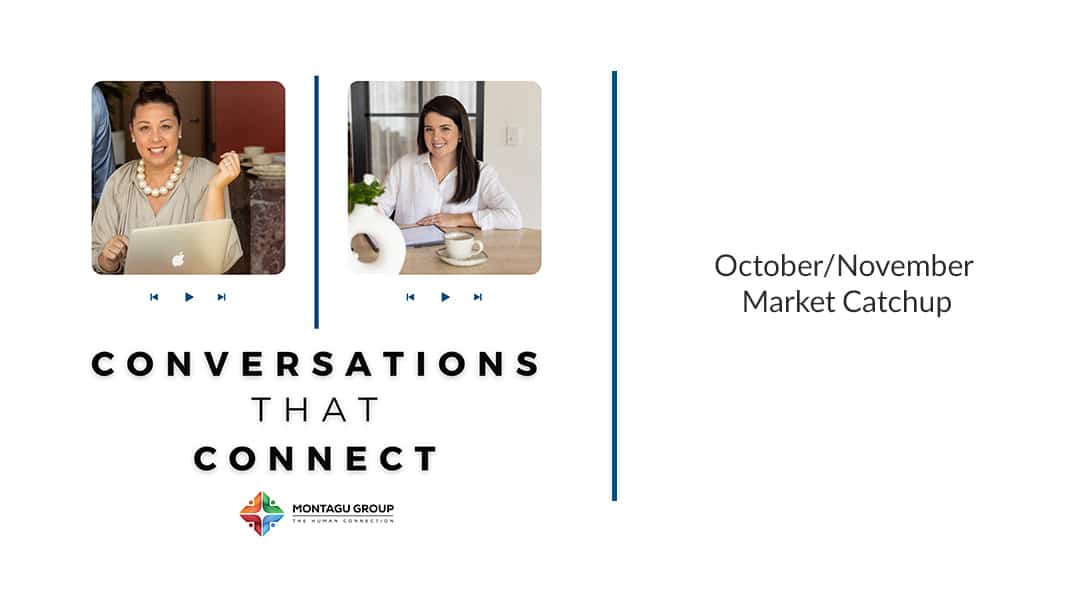
2025 Was a Rollercoaster
In this conversation, Suki and Tayla reflect on the rollercoaster year of 2025, discussing the ups and downs they experienced, the importance of building relationships, and the support they provided to their community. They also look ahead to 2026, emphasizing the need to embrace opportunities and take calculated risks while maintaining a positive outlook for the future takeaways!
2025 Was a Rollercoaster
If you’ve worked in recruitment, tech, digital, consulting, or frankly any industry this year, you’ve probably felt it — the sudden highs, the unexpected dips, and the moments where you found yourself thinking, wait… what now?
As we look back, one thing is unmistakably clear: 2025 was a rollercoaster. The year delivered sharp turns, surprising momentum, and plenty of opportunities to practise resilience and adaptability. However, it also reinforced something deeply grounding for us at Montagu Group:
Relationships — steady, real, and human — carried us through the turbulence.
The IT recruitment market in 2025 reshaped itself more times than we can count. Therefore, we wanted to reflect on the challenges, the wins, and the lessons that will continue to influence candidates, clients and the industry as we step into 2026.
A Market That Moved in Every Direction (Sometimes All at Once)
The IT recruitment market in 2025 defied prediction. At times, it felt unusually quiet. At other times, it surged with surprising intensity. Then, without warning, it swung somewhere in between.
January set the initial tone. We returned from Christmas to five new contract roles in the first week alone. For a moment, it appeared that the year would be a sprint. However, the momentum soon shifted as organisations paused hiring, delayed approvals, or restructured altogether.
In addition, some months brought a sudden resurgence of demand. Other periods left both candidates and hiring managers unsure about what direction the market was heading.
Despite this, one truth held steady: good candidates still found great jobs.
It often took longer than usual, yet those who stayed visible, open to conversation, and willing to adapt ultimately succeeded.
This unpredictability highlighted something important about the Australian tech ecosystem:
Talent will always win — even when timing doesn’t.
The Emotional Weight of 2025: Tired, Unsure, and Still Showing Up
If we had to choose one word to describe the emotional experience of 2025, it would be exhausting — not because people weren’t capable, but because the landscape kept shifting.
Redundancies, organisational restructures and market uncertainty took a toll. Meanwhile, candidates shared daily stories of feeling unsettled, overwhelmed or unsure about their next steps.
However, people also showed remarkable resilience. They sought clarity. They asked for direction. They invested in upskilling. As a result, our conversations became deeper and more strategic.
Small Conversations That Made a Big Difference
Again and again, candidates reached out simply needing a sounding board. For example, some needed help comparing two job offers. Others needed reassurance that the market wasn’t failing them — it was just in transition.
We saw:
-
Professionals questioning stability versus growth
-
Contractors seeking guidance on renewals or new projects
-
Teams trying to forecast budgets without clear organisational direction
-
Individuals wanting someone who understood the market beyond headlines
Ultimately, this year reminded us that recruitment has never been just about matching skills to roles. It’s about supporting people in moments of uncertainty — a responsibility we take seriously.
Relationships: The Anchor in a Chaotic Year
If there is one theme that defines our year at Montagu Group, it is thankfulness.
The Power of Steady Support in a Shifting Market
We were deeply humbled by the trust and connection shown by our clients, candidates and community. Importantly, these relationships provided stability in a year where very little felt stable.
1. Long-Term Partnerships That Held Strong
Several long-standing clients remained transparent, collaborative and supportive even while navigating their own uncertainties. Their commitment strengthened our partnership.
2. New Relationships That Energised Us
We had the privilege of partnering with organisations who understood our values and chose to collaborate with us during both busy and quieter seasons.
3. Candidate Connections That Became Lifelong
Some of our most meaningful interactions this year involved contractors who no longer worked with us yet stayed in touch because the relationship mattered. These connections reinforced the heart of our business.
Giving Back: The Most Important Work We Did All Year
One of our proudest achievements wasn’t measured in placements or metrics — it was the support we provided behind the scenes.
Throughout the year, we met with countless people navigating redundancy, insecurity or simply a difficult decision. Therefore, we spent more time than ever:
-
Reviewing résumés
-
Refining LinkedIn profiles
-
Talking through opportunities
-
Offering industry insights
-
Helping candidates find clarity and confidence
-
Guiding people through calculated risks
Behind-the-Scenes Support That Mattered
Much of this work was not transactional. It was human. Moreover, it reinforced our belief that recruitment is at its best when it serves people, not processes.
Risk, Opportunity and the Courage to Jump
A consistent message we shared this year was:
Take the risk — if it’s calculated.
Throughout 2025, many opportunities appeared unexpectedly. Importantly, candidates who leaned towards them, even with uncertainty, often discovered roles that significantly elevated their careers.
Furthermore, taking a risk didn’t mean being reckless. It meant asking questions such as:
-
Is this aligned with my long-term direction?
-
What is the realistic worst-case scenario?
-
Can I grow here?
-
What could this opportunity become?
As a result, several individuals found themselves thriving in ways they didn’t anticipate.
Peeking Into 2026: What Comes Next?
Nobody can perfectly predict the 2026 IT recruitment market, but we can look at trends developing late this year.
Cautious Optimism Will Shape the Start of 2026
-
Early 2026 may start quieter, similar to late 2025
-
Hiring will likely be strategic and intentional
-
Contracting demand should remain steady
-
Good candidates will still find strong opportunities
-
Networking and visibility will be essential
-
Organisations are beginning to transition beyond “post-COVID mode”
Furthermore, we’re observing a slow but noticeable shift as companies redefine what hybrid, onsite, and flexible work will look like in a more stable environment.
Ultimately, 2026 carries a sense of hope — not naive optimism, but grounded confidence that the market is ready to settle and rebuild momentum.
What We’re Most Grateful For
As we close out 2025, we want to acknowledge every person who allowed us to be part of their professional journey.
To Our Candidates:
Your trust, honesty and resilience made this year meaningful.
To Our Clients:
Your transparency, collaboration and openness allowed us to navigate challenges together.
To Our Community:
Your conversations, referrals and support reminded us why we love this work.
Importantly, strong relationships outlast volatile job cycles — and this year proved it.
Closing Out the Year: Rest, Celebrate and Reset
We’re taking a short break over the Christmas period to recharge. Meanwhile, we hope you can rest, reconnect and celebrate how far you’ve come.
Whether your festive drink of choice is a margarita, piña colada, champagne or iced latte, take a moment to acknowledge your resilience. You made it through a challenging year — and there is so much ahead.
Here’s to stepping into 2026 with hope, clarity, confidence, and maybe even a little delulu energy — because truly, how good could it get?
From all of us at Montagu Group,
Merry Christmas, and thank you for an unforgettable year.
Show Notes
In this episode, Suki and Tayla sit down to reflect on one of the most unpredictable recruitment years we’ve experienced in a long time. From rapid surges in IT contracting demand to sudden market slowdowns, 2025 kept everyone — candidates, clients, and recruiters alike — on their toes.
Across the ups and downs, one theme anchored the year: relationships.
This conversation dives into the realities of navigating a turbulent market while continuing to support people through redundancies, restructures, job uncertainty, and career decisions that required real courage.
Suki and Tayla share honest insights into:
-
How the IT and digital recruitment market shifted unexpectedly throughout the year
-
What made 2025 uniquely exhausting for candidates and hiring managers
-
Why long-term relationships and steady communication mattered more than ever
-
How Montagu Group supported people through challenging moments with practical guidance and behind-the-scenes career help
-
The role that calculated risk played for candidates stepping into new opportunities
-
What we’re expecting — cautiously but optimistically — in early 2026
As we wrap up the year, this episode is both a reflection and a reminder that resilience, connection, and kindness still drive the best outcomes in recruitment.
Key Takeaways
1. 2025 was unpredictable — even by recruitment standards.
The year started with momentum, dipped unexpectedly, and bounced around in ways no one saw coming. The tech and digital hiring landscape was shaped by restructures, budget pauses and fluctuating demand — sometimes all within the same quarter.
2. Good candidates still found good jobs.
Even in a softer market, high-quality candidates continued to secure roles. Timing sometimes stretched out, but staying active, connected and visible always paid off.
3. People were tired — and the emotional weight was real.
Redundancies, organisational change and market uncertainty left many candidates unsure, overwhelmed or seeking reassurance. A large part of our role this year became emotional and strategic support.
4. Relationships were the anchor.
Long-term client connections held strong. New relationships flourished. Contractors stayed in touch even after finishing assignments. Trust and communication made the biggest difference this year.
5. Giving back mattered.
From résumé reviews to interview prep to talking candidates through opportunities they weren’t sure about, much of our most meaningful work in 2025 happened off the clock — in conversations that built confidence and clarity.
6. Calculated risks led to big wins.
Many candidates took a leap this year — and it paid off. In an unpredictable market, carefully considered risks often created the best outcomes.
7. 2026 will begin with cautious optimism.
We expect a similar pattern to late 2025 — measured, intentional hiring with strong activity for niche technical skills. Organisations are also beginning to shift out of the “post-COVID shadow,” which may reshape workplace expectations next year.
8. Community and support still matter more than algorithms.
AI is changing recruitment, but human connection — empathy, clarity, guidance — was the difference-maker for many people this year.
9. Montagu Group is incredibly thankful.
To the candidates who trusted us, the clients who collaborated with us, and the community who shared their challenges and wins — your support shaped our year.
If you have a burning topic you’d like to discuss, don’t hesitate to reach out at hello@montagu.com.au.
Join the conversation Today!
click on the button to see a full list of posts from our Conversations that Connect deep dives!
Stay Up to Date With Our Latest Episodes
enter your email to be notified when we release a new episode of Conversations that Connect.




